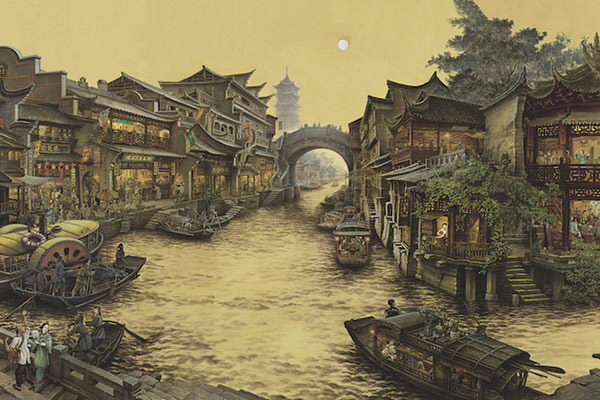
Zhang Xiaoyou’s jiehua painting Old Days of Southern River Towns captures details of a night scene in a typical river town of southern China. [Photo provided to China Daily}
In 1940s’ Shanghai, a 5-year-old was the only boy studying at a Catholic girls’ primary school in the French Concession.
His parents then felt their thin and weak son would be better taken care of by the nuns. He was also watched over by his teenage cousin, who also attended the school.
The boy, Zhang Xiaoyou, learned how to stitch and often received European postcards as rewards for his work. After school, he liked to browse through picture books at street stands. He loved visiting the nearby St. Peter’s Catholic Church, a 1930s Byzantine-style structure, where music from the imposing pipe organ and the murals sparked his interest in art.
“My family hoped that when I grew up I would become an architect or a doctor,” he says.
But Zhang ended up choosing painting as a career. Since his retirement from Tsinghua University’s academy of arts and design in the late 1980s, Zhang, now 81, has specialized in reviving the dying art of jiehua, or boundary painting.
Jiehua evolved as an important part of Chinese ink-and-wash painting during the Sui (AD 581-618) and Tang (AD 618-907) dynasties. But as it primarily depicted architecture, vessels and vehicles, painters were required to be accurate, proportional and meticulous in their illustrations.
They were also allowed to draw lines using rulers. But they needed to master brushwork just like in gongbi (meticulous brushwork) painting.

Zhang Xiaoyou [Photo provided to China Daily]
Jiehua provides a visual treat and was useful when producing blueprints for pavilions, terraces and towers. For that reason, the painting style was earlier seen as being too industrial and not artistic enough when compared to the more abstract and elevated shanshui (mountain-and-water) style.
But with Zhang’s works, one understands how he is working to change that perception, and breathe new life into the jiehua genre.
His paintings are now on display, along with the works of former colleagues at Tsinghua University, at the Shaoxing Art Museum in Shaoxing, Zhejiang province, through Aug 31.
Among the works are Old Days of Southern River Towns, a 4-meter-long scroll on silk that captures a night scene in a typical river town of southern China in the late Qing Dynasty (1644-1911).
With his attention to detail, Zhang juxtaposes various architectural forms-including gate towers, arches, roofed bridges, pavilions with open halls and pagodas.
The work also has a linear perspective-common in Western painting-which makes it even more vivid.
The work has a poetic, earthy quality and a quiet elegant tone to it, reminding one of the classic Along the River During the Qingming Festival by 11th-century painter Zhang Zeduan.
Zhang’s skills come from both traditional Chinese and Western art, which he learned at Beijing’s Central Academy of Fine Arts from 1954-59.
Zhang, who was one of only 16 students who enrolled at the academy when he was chosen, then studied under the guidance of modern masters of both ink art and oil painting, such as Wu Zuoren, Li Keran and Dong Xiwen.
Zhang’s classmates then included Yuan Yunsheng and Zhu Naizheng, who later become established oil painters.
“We were to be educated to be ‘experts at fine art’, said the student recruitment notice,” Zhang recalls.
After graduation, he taught sketching at the college until he retired in 1985. He also coproduced huge “red classic” canvases commissioned by the Revolutionary History Museum, now the National Museum of China, during his years at the academy.
His interest in jiehua was ignited during a trip to Thailand in the late 1980s.
There, he found a brochure on this form of Chinese painting.
Speaking about how he became interested in the genre, he says: “We had learned the basics of Chinese painting at the preparatory courses in the first year at the CAFA. Then, I specialized in oil painting. But it didn’t occur to me until reading that small booklet that jiehua had existed as an independent genre.”
After returning home, he began searching for materials on the genre but found it was dying as very few painters were practicing it.
Speaking about what he saw, he says: “No one took it seriously. And it took days and weeks to complete a painting because of the detailed work needed.”
Zhang then decided to use his decades of experience as an oil painter and his knowledge of Chinese painting techniques to revive jiehua.
He also began studying ancient Chinese architecture to make his works more realistic.
Now, he also seeks inspiration from the Dunhuang murals, which he copied during his frequent visits to Gansu province in the early 1980s.
Zhang’s jiehua paintings are now with museums and private collectors at home and abroad.
He currently paints about eight hours a day. He is looking to pass on the baton to younger painters.
